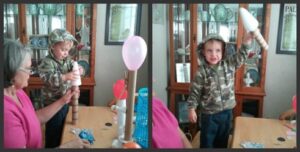The Spark
I was watching Jack, almost 3, and Mary, who was 10 months old. It was getting crazy. I was trying to write an article and keep the Christmas Tree from tipping over for the third time that day. I began asking myself, “What can I get Jack interested in?” We have a large rain stick in the living room, so I got it out.
Jack was fascinated. He tipped it upside down many times to hear it “rain”. I asked him if he knew how the rain stick worked. He didn’t. So, I used my fingers to explain how there were crossed spines inside and small seeds. When the seeds hit the spines, they made the sound. I could see he was a bit confused.
Figuring It Out
“Jack, do you know what a cactus is?” “No?” “I’ll bet we can find one on the computer.” (I didn’t have any books on cacti in my library.) We went to the computer and pulled up some pictures of cacti. I explained that when the cactus dies, the arms can be made into rain sticks before they dry. I showed him some cacti with long spines and explained that the spines are pushed into the dead cactus. We got our rain stick, and I was able to let him feel the ends of the spines in the stick.
With Jack on one knee and Mary on the other, we googled making a rain stick. The first thing up was a video series showing how to make a rain stick from a cardboard tube. We watched the video on how to choose a tube. We watched how to insert the spines, which were made of nails, pins, or toothpicks. We watched the first part on covering the tube ends, and finished off with the video on what to put inside.
Jack was fascinated and watched all the videos. He didn’t get bored or wiggly. I helped him stay tuned in by having mini-conversations. “Look, Jack, there are three lengths of tubes. Which size would you choose?” “Hey, look, she is using nails and a hammer. You would like to hammer nails, I bet.” “See those toothpicks, they would make a really different sound.” It went on and on, and he was fully engaged with how it was done. (The hardest part so far was keeping Mary’s hands busy and off the keyboard!)
Creating Our Rainstick
“You know what, Jack, I’ll bet we can make a rain stick.” “Yeahhhhh”, he said. We pulled out our really great junk box and found a long tube that we thought might work. I handed it to Jack, he put it up to his eye and said, “Hey, it’s my looker looker”; so much for the rain stick. LOL
We took our tube, some straight pins, and duct tape to the kitchen. Jack was content to watch me make the rain stick. He tried pushing in a pin, but decided it hurt his thumb. We talked about dead cacti, thorny spines, and rain sticks while I pushed in pins and taped on an end. Jack chose red lentils and rice to put inside.
He was interested in how the spines looked from the inside of the tube. He understood now what I had been showing him with my fingers, and he showed it back to me. Then I taped the other end and covered the whole thing with duct tape. A rain stick is normally covered with paper or cloth and then painted or decorated, but I wanted to be sure those pesky pins didn’t come out.
Jack excitedly turned it over. It didn’t “rain”. There was just a spattering thunk. Hmmmmm. He tried it a few times. Then he looked at me and, with a serious face, said, “It’s too little,” (meaning short). He had figured out that there was no rain sound because the tube was too short. Amazing! Aren’t children smart?
I told him that we could construct a rain stick out of three toilet paper tubes taped together. He was all for that and rummaged in the junk box for the tubes. Then his enthusiasm waned. He and Mary busied themselves with trucks on the living room carpet while I taped the tubes together. Then I called Jack in and told him I was going to use toothpicks this time and showed him how it would work. Then he was off again to Mary and the trucks. I finished the tube and called Jack in to put the rice inside. I finished taping the ends and covered them with duct tape. Then I called Jack, and he gave it a try. His face beamed when it “rained.”
When his mom returned home, he showed her the rain stick, and I explained about the dead cactus. She said, “Jack knows about cacti. Remember the story about the boy and his bottom.” A wide grin spread over Jack’s face as he recalled the Dr. Seuss story about a boy who sat on a cactus. Now it all came together in his mind.
It was a great time and took only about forty minutes from start to finish; just a mere 40 minutes, and Jack learned so much and had a lot of fun. Then I went back to my article, and Jack and Mary played with the trucks till their mom got home.
Helping children LOVE learning is about catching a spark from a child (in this case, seeing Jack’s interest in the rain stick), then responding.


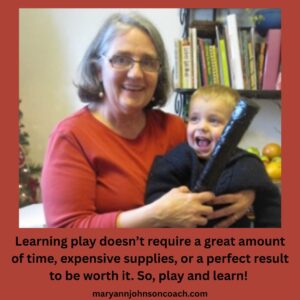
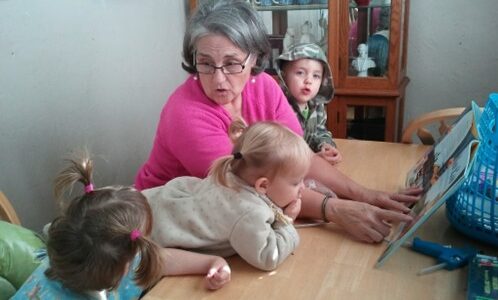
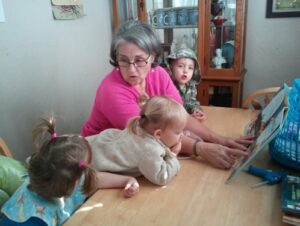 One day in 2011, I found the most amazing book at the library!!! I happened across it accidentally. It was about Leonardo Da Vinci and the amazing visions he had. But that wasn’t all. The book showed how, in time, all his inventive ideas were created by other people and who those people were. Oh my gosh, I wanted to share this with my grands.
One day in 2011, I found the most amazing book at the library!!! I happened across it accidentally. It was about Leonardo Da Vinci and the amazing visions he had. But that wasn’t all. The book showed how, in time, all his inventive ideas were created by other people and who those people were. Oh my gosh, I wanted to share this with my grands.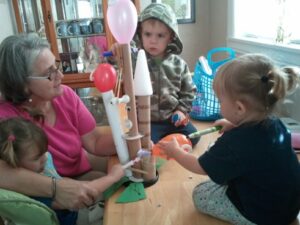 Our Super-duper Rocket-propelled Robot
Our Super-duper Rocket-propelled Robot